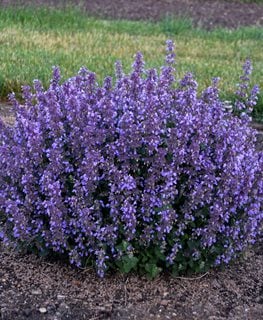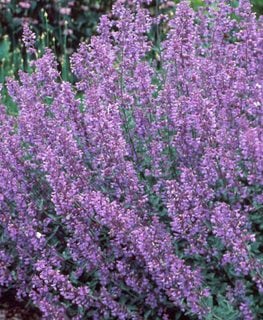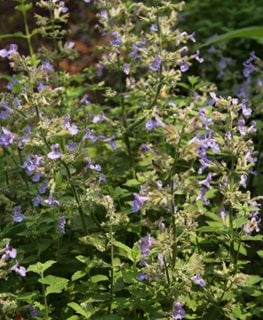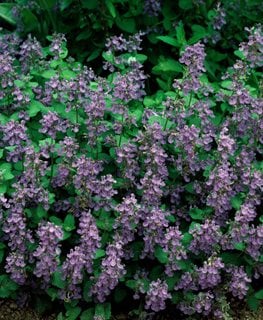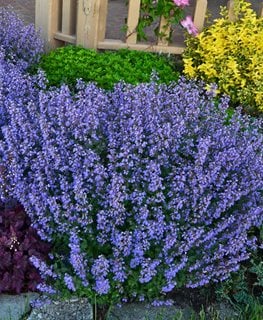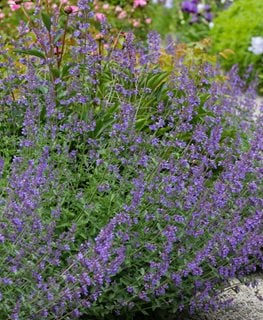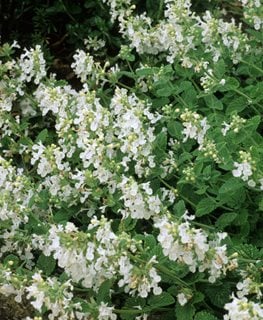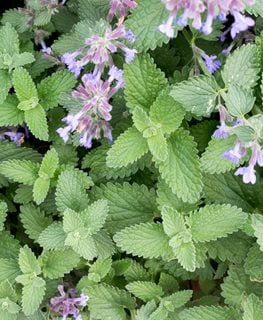How to Grow & Care for Catmint (Nepeta)
A long bloom season, handsome foliage, and carefree performance are just a few of the allures of this versatile perennial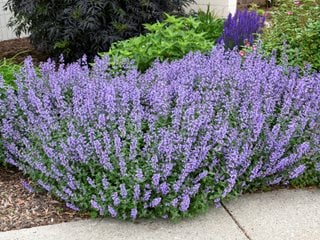
2025 Landscape Perennial of the Year: ‘Cat’s Meow’ catmint (Nepeta ×faassenii). Photo by Proven Winners.
If you’re looking for a tough-as-nails plant that will bloom for months on end with very little pampering, catmint is sure to make you purr with delight. Unlike its close relative catnip (both are members of the mint family), catmint is better behaved and much showier. The soft gray-green foliage and billowy clusters of lavender-blue flowers are like a cool breeze on a hot day.
With variations in both flower and foliage color, height, bloom time and growing conditions, these multipurpose plants can be used in almost any area of the garden.
On this page: Basics | Varieties | Planting | Care | Pictures | FAQs | Design Ideas
On this page:
- BASICS
- VARIETIES
- HOW TO PLANT CATMINT
- CATMINT CARE
- CATMINT PICTURES
- FREQUENTLY ASKED QUESTIONS
- LANDSCAPING IDEAS
BASICS
Plant type:
Herbaceous perennial
Zones:
3-9, depending on variety
Exposure:
Full sun to light shade.
Height:
9 inches to 3 feet, depending on variety
Flower color:
Various shades of lavender-blue, pink, violet, or white; often enhanced by darker calyces.
Foliage:
Fuzzy, aromatic gray-green to medium-green leaves with scalloped edges. "The foliage is just as delightful as the flowers, releasing a minty fragrance when brushed against." — Stacy Ling, master gardener.
Bloom time:
Typically, late spring to early summer into early fall, although some varieties bloom earlier and longer.
Special attributes:
- Heat and drought tolerant.
- The minty, aromatic leaves make them rabbit and deer resistant.
- Attracts bees, butterflies and other beneficial insects.
CATMINT VARIETIES
Not sure which catmint variety is right for you? Watch this video with Andrew from Proven Winners Perennials as he compares 8 different varieties.
- Nepeta x faassenii (Faassen’s catmint): By far, the most popular cultivars grown for ornamental use belong to this hybrid, which has sterile flowers that won’t self-sow and don’t require deadheading.
- Nepeta subsessilis (Japanese catmint): Unlike other varieties, this one prefers moist soil and partial shade, making it a good option for cooler, wetter climates.
- Nepeta racemosa (Persian or dwarf catmint): This low-growing species forms rounded mounds that spread as wide as the plants are tall. Ranging in height from 12 to 18 inches, it is often used as a colorful groundcover.
HOW TO PLANT CATMINT
Where to plant:
Although most prefer full sun, they won’t mind a bit of afternoon shade, especially when grown in hot climates. Catmint grows easily in most soil types, including rocky or clay soils, but performs best in well-drained conditions to prevent root rot. For containers, use a high-quality all-purpose potting mix.
When to plant:
Plant in spring after the last frost, or anytime through early fall.
How to plant:
Dig a hole about twice as wide as the root ball and just as deep. Gently loosen the roots before placing the plant in the hole, then backfill with soil and water well.
Spacing:
Space plants according to their mature width, usually about 18 to 24 inches apart, to allow for spreading.
Note: While catmint can be grown from seed, it's best to purchase nursery-grown plants for reliable results, especially with sterile hybrids that may not grow true from seed.
CATMINT CARE
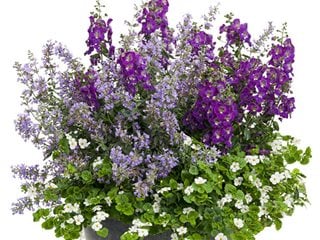
Use catmint in mixed containers like this “Brooklyn Heights” recipe that includes ‘Cat’s Meow’ catmint, Angelface® Blue Angelonia, and Snowstorm® Giant Snowflake® bacopa. Photo by Proven Winners.
Water requirements:
Water newly planted catmint regularly during its first growing season to help establish a strong root system. Once established, most varieties are drought tolerant and can thrive with minimal supplemental water in cooler or humid climates. However, in hot, dry regions—especially during extended drought—occasional deep watering may be necessary to keep plants looking their best. Japanese catmint (N. subsessilis) prefers consistently moist soil and will need more frequent watering regardless of climate.
Fertilizing:
Given the right growing conditions, catmint is unlikely to need fertilizing, and applying it can even result in floppy stems and fewer flowers. According to the National Gardening Association, “An annual layer of compost in fall or spring should provide catmint with all the nutrients it needs.”
Pruning:
Some plants may go into a summer lull after the first flush of blooms has faded. Shearing your plants back by a third or more will reenergize them for a second bloom cycle and produce lush new foliage. Even without being sheared, they will often repeat bloom, although not quite as prolifically.
Deadheading is unnecessary to prevent self-sowing because the seeds of hybrids are sterile. However, it may help stimulate new flower development.
Dividing:
It is one of the easiest plants to divide, and doing so every 3 or 4 years in fall will help to keep it vigorous. Simply use a spade to separate rooted sections of an established plant and then replant the divisions, spacing them about a foot apart.
Pests and Diseases:
May be bothered by thrips, which are best treated with insecticidal soap or neem oil. Catmint can also help repel certain pests. The North Carolina State Extension notes it “acts as a repellent for certain insects, including aphids and squash bugs.”
CATMINT PICTURES
Love perennials? Learn more about them, along with timely planting advice, garden design inspiration, practical tips and more in our weekly newsletter.
FREQUENTLY ASKED QUESTIONS
Is catmint the same as catnip?
Catnip (Nepeta cataria) is more aromatic than catmint. Its ornamental attributes are lacking and it tends to be weedy and invasive. In the garden, it offers the most value as a culinary herb or as a repellant for certain insects, including mosquitoes, aphids and squash bugs.
Is catmint invasive?
Most catmint varieties, especially hybrids like Nepeta ×faassenii, are non-invasive and won’t self-seed aggressively. Choose sterile cultivars if reseeding is a concern.
How long does catmint bloom?
Catmint typically blooms from late spring into early fall. Many varieties will rebloom if sheared back after the first flush of flowers.
Will catmint rebloom if cut back?
Yes. Cutting plants back by about one-third after the first bloom often encourages a second, lighter bloom and fresh new growth.
Can I grow catmint in containers?
Absolutely. Catmint grows well in containers—just be sure to use a high-quality potting mix and a container with good drainage.
Does catmint repel mosquitoes?
Yes, certain types of catmint, especially catnip (Nepeta cataria), contain compounds that can help repel mosquitoes. While ornamental catmints (Nepeta ×faassenii, N. racemosa, etc.) may have some mild repellent qualities, they’re primarily grown for their beauty rather than pest control.
LANDSCAPING IDEAS
Garden uses:
Butterfly gardens, borders, herb gardens, mass plantings, groundcovers, rock gardens, and as an edging plant along walkways. Can also be used as a substitute for lavender, since they share a similar color palette.
Good companions:
Catmint’s cool-toned flowers pair well with a range of colors, especially reds, purples, pinks, and yellows. Try combining it with:
- Red: Red valerian, monarda, Veronica 'Red Fox'
- Purple: Purple basil, drumstick alliums, coral bells (Heuchera 'Wild Berry')
- Pink: Pink roses, coneflower, salvia
- Yellow: 'Moonshine' yarrow, coreopsis, 'Stella de Oro' daylily
A classic combination, according to the National Gardening Association, is pairing catmint with hybrid tea roses to cover the “bare knees” of the rose bushes and complement their blooms with soft blue flowers.
ABOUT THE AUTHOR
Anne Balogh is a longtime gardening writer and editor for Garden Design, with over 20 years of experience covering everything from container planting to landscape trends. She draws inspiration from her own Zone 5 garden in Illinois, where she experiments with hardy perennials and flowering annuals.
RELATED:
The 24 Best Plants to Attract Hummingbirds
24 Purple Flowers to Brighten Your Garden
20 Drought-Tolerant Plants for Your Garden
20 Full-Sun Perennials
20+Cottage Garden Plants & Flowers

